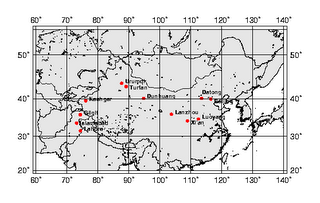The silk road
 The region separating China from Europe and Western Asia is not the most hospitable in the world. Much of it is taken up by the Taklimakan desert, one of the most hostile environments on our planet. There is very little vegetation, and almost no rainfall; sandstorms are very common, and have claimed the lives of countless people. The locals have a very great respect for this `Land of Death'; few travellers in the past have had anything good to say about it. It covers a vast area, through which few roads pass; caravans throughout history have skirted its edges, from one isolated oasis to the next. The climate is harsh; in the summer the daytime temperatures are in the 40's, with temperatures greater than 50 degrees Celsius measured not infrequently in the sub-sealevel basin of Turfan. In winter the temperatures dip below minus 20 degrees. Temperatures soar in the sun, but drop very rapidly at dusk. Sand storms here are very common, and particularly dangerous due to the strength of the winds and the nature of the surface. Unlike the Gobi desert, where there there are a relatively large number of oases, and water can be found not too far below the surface, the Taklimakan has much sparser resources.
The region separating China from Europe and Western Asia is not the most hospitable in the world. Much of it is taken up by the Taklimakan desert, one of the most hostile environments on our planet. There is very little vegetation, and almost no rainfall; sandstorms are very common, and have claimed the lives of countless people. The locals have a very great respect for this `Land of Death'; few travellers in the past have had anything good to say about it. It covers a vast area, through which few roads pass; caravans throughout history have skirted its edges, from one isolated oasis to the next. The climate is harsh; in the summer the daytime temperatures are in the 40's, with temperatures greater than 50 degrees Celsius measured not infrequently in the sub-sealevel basin of Turfan. In winter the temperatures dip below minus 20 degrees. Temperatures soar in the sun, but drop very rapidly at dusk. Sand storms here are very common, and particularly dangerous due to the strength of the winds and the nature of the surface. Unlike the Gobi desert, where there there are a relatively large number of oases, and water can be found not too far below the surface, the Taklimakan has much sparser resources.
The land surrounding the Taklimakan is equally hostile. To the northeast lies the Gobi desert, almost as harsh in climate as the Taklimakan itself; on the remaining three sides lie some of the highest mountains in the world. To the South are the Himalaya, Karakorum and Kunlun ranges, which provide an effective barrier separating Central Asia from the Indian sub-continent. Only a few icy passes cross these ranges, and they are some of the most difficult in the world; they are mostly over 5000 metres in altitude, and are dangerously narrow, with precipitous drops into deep ravines. To the north and west lie the Tianshan and Pamir ranges; though greener and less high, the passes crossing these have still provided more than enough problems for the travellers of the past. Approaching the area from the east, the least difficult entry is along the `Gansu Corridor', a relatively fertile strip running along the base of the Qilian mountains, separating the great Mongolian plateau and the Gobi from the Tibetan High Plateau. Coming from the west or south, the only way in is over the passes.













No comments:
Post a Comment